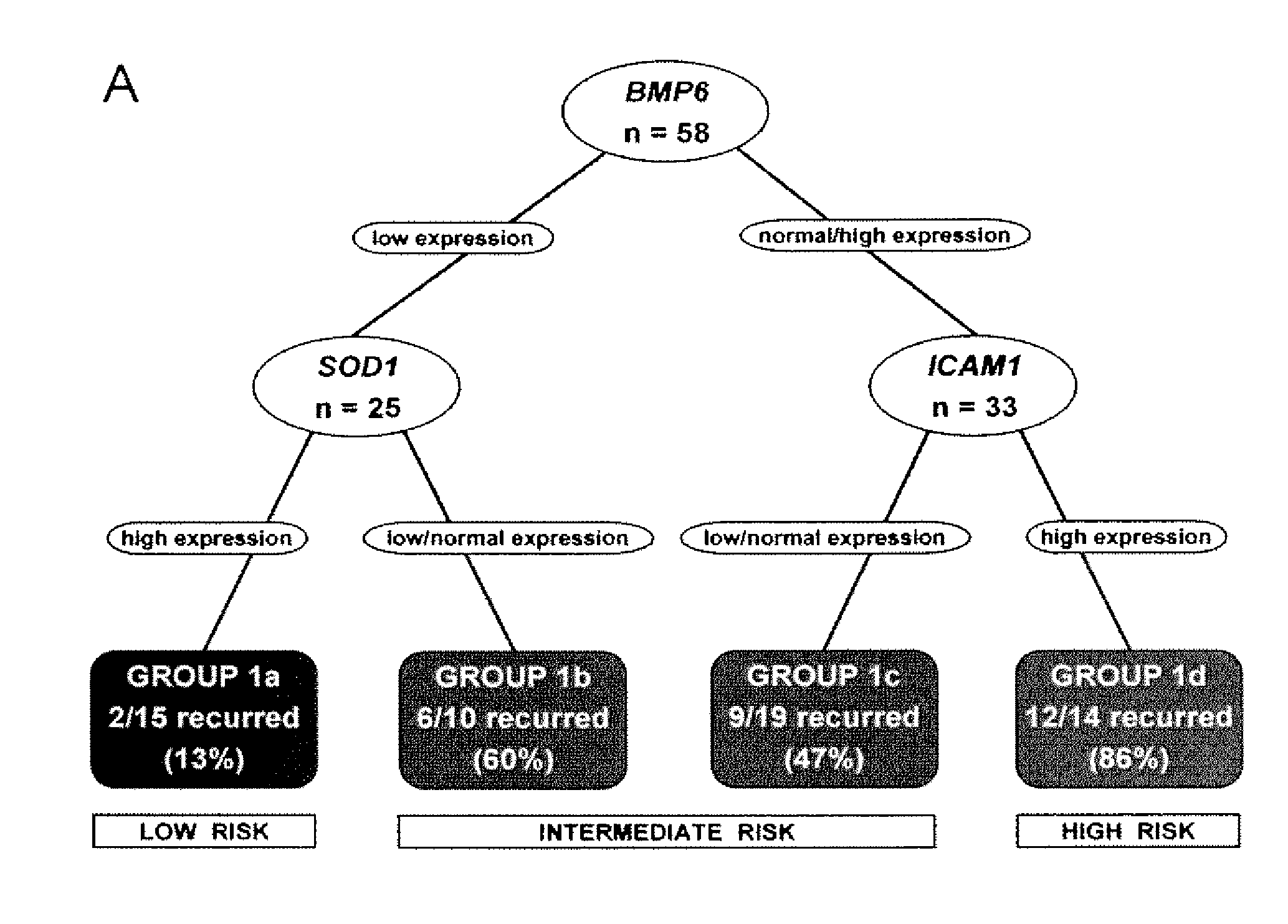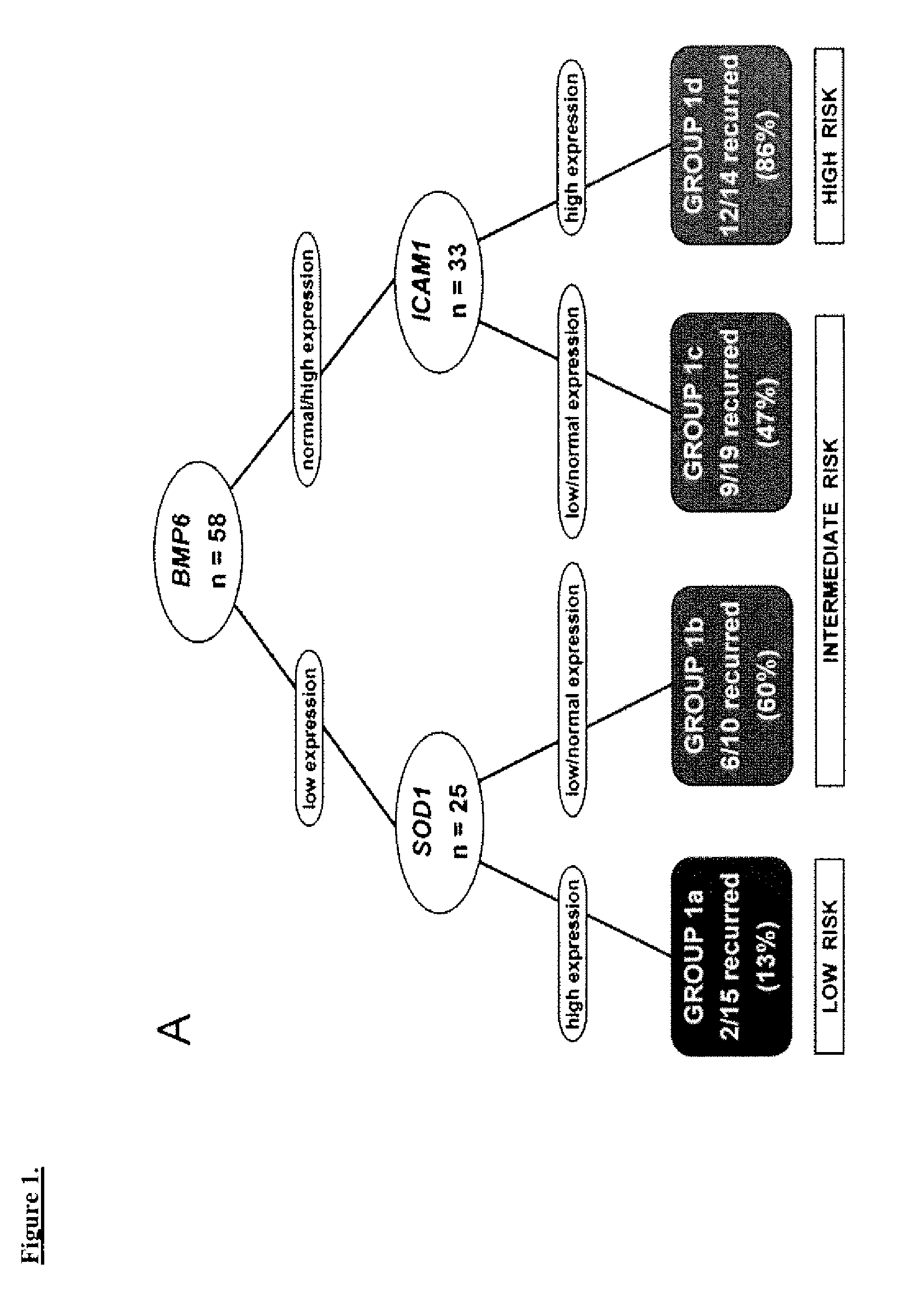Prognostic panel for urinary bladder cancer
a technology for predicting the outcome of urinary bladder cancer, applied in the direction of instruments, organic chemistry, biochemistry apparatus and processes, etc., can solve the problem of inability to predict the outcome of an individual patien
- Summary
- Abstract
- Description
- Claims
- Application Information
AI Technical Summary
Benefits of technology
Problems solved by technology
Method used
Image
Examples
example 1
Patient Selection
[0055]The study cohort comprised 58 UC patients (mean age 69.5 years) and five normal controls. Frozen CC tissue was obtained after radical cystectomy from 49 patients at the University of Southern California and 9 patients at the University of California, San Francisco between 1991 and 2002. These included patients with invasive (T1-T4) tumors, and noninvasive (Ta) tumors refractory to bladder-conserving therapies. Specifically, the study cohort included 10 Ta, 11 T1, 10 T2, 21 T3 and 6 T4 patients. Patients with distant metastasis at the time of diagnosis were excluded. TNM staging was standardized to the 2002 AJCC recommendations1. Controls consisted of normal urothelium from the bladder neck of patients who underwent radical prostatectomy for localized prostatic adenocarcinoma without bladder involvement and no history of UC.
[0056]8 patients (13.8%) received adjuvant chemotherapy and / or radiotherapy. These included patients with high grade, recurrent noninvasive...
example 2
StaRT-PCR, and Comparison of Tumor and Normal Gene Expression Levels
[0057]After RNA extraction by the conventional TRIzol method (Invitrogen, Carlsbad, Calif.), CDNA was prepared and quantitative gene expression profiling performed by StaRT-PCR (Gene Express, Toledo, Ohio), as previously described7,8. The internal standard mixtures (A-F, over six logs of concentration) contained competitive templates (CT) of 69 transcripts in addition to 600,000β-actin CT molecules / μL (Gene Express, Toledo, Ohio). For each sample, StaRT-PCR analysis was performed using five different CT mixes (B-F). Thus each sample underwent five separate PCR analyses; each separate reaction containing the ready-to-use master mixture, cDNA sufficient for expression measurements of the 70 transcripts (including β-actin), primers for the 70 transcripts and one of the five CT mixes (B-F). Following PCR, the amplification products were electrophoresed, and image analysis and quantitation of band fluorescence intensitie...
example 3
[0059]The clinical outcomes analyzed were time to recurrence, disease-specific survival, and overall survival. Time to recurrence was calculated from date of cystectomy to the first date of clinical recurrence or progression. Patients without recurrence or progression were censored at the time of death or last follow-up. Disease-specific survival was calculated from date of cystectomy to the date of death from UC or the last follow-up date. Overall survival was calculated from date of cystectomy to the date of death from any cause; patients who were still alive were censored at the date of last follow-up. Time to recurrence was preferred over disease-specific survival since currently most patients who die of UC have a documentation of disease recurrence; overall survival also accounts for cases where cause of death may be unknown and where the impact of UC treatment may contribute to death although the disease does not recur.
[0060]The log-rank test9 was used to examine ...
PUM
 Login to View More
Login to View More Abstract
Description
Claims
Application Information
 Login to View More
Login to View More - R&D
- Intellectual Property
- Life Sciences
- Materials
- Tech Scout
- Unparalleled Data Quality
- Higher Quality Content
- 60% Fewer Hallucinations
Browse by: Latest US Patents, China's latest patents, Technical Efficacy Thesaurus, Application Domain, Technology Topic, Popular Technical Reports.
© 2025 PatSnap. All rights reserved.Legal|Privacy policy|Modern Slavery Act Transparency Statement|Sitemap|About US| Contact US: help@patsnap.com



